
When these fighting fish were found motionless on the surface of the water, STOMPer Chong attempted to scoop them out of the water. Much to his surprise, they jumped back into the water as soon as he scooped them up.
It was then that he realised that his fighting fish were not dead but were just sleeping.
He says:
"Aren't they just so cute to be sleeping above the water?
"They're lying there exposed to the air, half submerged in water.
"One of them was even lying on the leaf.
"I had thought they were dead so I tried to scoop them out but they jumped out and gave me a shock."
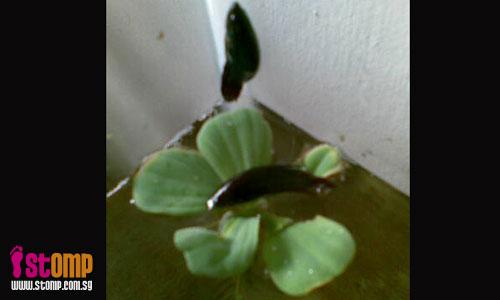
I don't have a lot of experience with keeping Siamese fighting fish (Betta splendens), but I am quite sure that they do not habitually spend time out of the water.
What I do know however, is that Siamese fighting fish (also commonly known among aquarists as bettas) are very good at jumping, which is why it is essential to have a screen or some sort of cover over your aquarium.
I found a very interesting nugget of information at this site:
Often Bettas jump simply because they can but it may also be a sign that your water quality isn't what it needs to be. If you have a jumper follow up with the usual water tests. Check your ammonia, nitrite, nitrate and pH. Rather then jumping some bettas will hoist themselves on top of a leaf or other floating decoration. If you notice this behavior double check your water parameters to rule out poor water quality as the culprit. Often the reason is benign but it's best to know for certain if your Betta is trying to tell you something.
If true, I suspect that this is what is going on with this person's fish, that they are attempting to escape because a water change is long overdue. So it's not 'cute', but a genuine cause for concern.
In the wild, jumping might serve as a survival mechanism that enables them to seek out nearby pools of water with better living conditions. Of course, in the average home, such an act is invariably fatal if the fish is not retrieved soon enough.
The Siamese fighting fish is a member of a unique group of fish known as anabantoids or labyrinth fish, which are largely restricted to tropical Africa and Asia, with a few species known to inhabit temperate freshwaters of southern Africa and east Asia. The members of this group all possess a specialised labyrinth organ in their gill chambers that enables them to breathe atmospheric air. This allows many of them to survive in sluggish streams and small, stagnant pools and puddles in forests, seasonally flooded wetlands, and rice paddies. These habitats are often warm and oxygen-depleted, and so the anabantoids living in such water bodies are capable of tolerating conditions that would kill most fish wholly dependent on absorbing dissolved oxygen through their gills. In fact, it is said that anabantoids will actually drown if they are prevented from breathing air at the surface!
The labyrinth organ also enables several species to survive for some time out of water, as long as their skins remain moist. In this way, some anabantoids are able to survive temporary drying out of their pools, or are even capable of moving about on dry land from one pool to another. The species most well-known for its occasional terrestrial habits is the climbing perch (Anabas testudineus), which is a widespread and adaptable species, and quite often spotted in a wide variety of both natural and man-made aquatic habitats in Singapore; when I was in my early teens, I caught a climbing perch in a concretised section of Sungei Api Api in Tampines and kept it as a pet for a few years.

Climbing perch
(Photo by Frank Teigler)
Because of this ability to breathe atmospheric air, Siamese fighting fish are able to survive for some time in tiny puddles and pools. It's also why Siamese fighting fish are commonly kept and displayed in small jars and bottles.

Siamese fighting fish for sale in Phnom Penh market
(Photo by Angela Savage)
However, just because these fish are sometimes found living in small stagnant pools, doesn't mean that this is the ideal habitat, and does not imply that they can thrive in such conditions indefinitely. Their hardiness and tolerance for some degree of neglect and abuse is certainly no excuse to compromise on water quality.
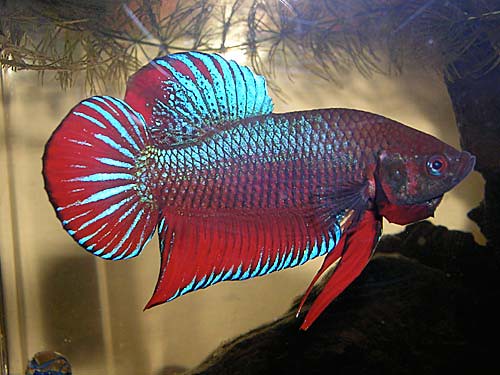
Siamese fighting fish;
(Photo by wobbly_sphinx)
This species gets its common name from the fact that males are very territorial, and are extremely aggressive towards other male bettas. If a male should see another male, he will flare out his gill covers and fully expand his fins, making him appear larger and more threatening. If this threat display does not drive away the trespasser, then the male will attempt to chase his rival away, nipping at fins and scales. Males will even attack their own reflections, and display to males in adjacent jars. Needless to say, males are best kept on their own; in the wild, there is a chance for males to swim away and escape the attention of rivals, but within the confines of an aquarium, one of them will inevitably be harassed to death. Even females are not safe, since she will be driven away from a male's territory if she is not ready to breed. Siamese fighting fish can be kept in community aquariums, but tankmates must be carefully selected; long-finned fish will often become the target of the Siamese fighting fish's aggression, whereas other species might nip at the long flowing fins commonly seen in captive-bred varieties of Siamese fighting fish.
This combative behaviour has made the species highly popular in communities all over Southeast Asia. As stated in A Guide to the Freshwater Fishes of Singapore:
The popularity of the Siamese Fighting Fish is a good example. Male fish are kept individually in small jam-jars, shielded from each other by pieces of cardboard to prevent them from exhausting themselves by trying to get at one another through the glass. Some people claim that the fish can be "trained" to be fierce fighters by keeping them in water soaked with dead leaves or "chilli-padi" (to improve its colour and/or ferocity), or some other secret concoctions. The fighting arena usually comes in the form of a simple wash basin. The fighters are only removed when one of the torn and tattered fishes, the loser, starts to flee for its life.
Indeed, in a region where people place bets on fights between all sorts of creatures, from crickets, beetles and jumping spiders, to roosters and water buffalo, perhaps gambling on two small fish fighting in a jar doesn't seem so odd after all.

Men watching Siamese fighting fish in Hanoi
(Photo by stephco)
What is amazing about the anabantoids as a whole is the fact that they engage in many fascinating behaviours. Several species of anabantoids are bubblenesters; the male builds and maintains a floating mass of bubbles, and after mating takes place, the male deposits the eggs amongst the bubbles. There the eggs develop, guarded by the male, who continues to repair the bubblenest and tend to his brood until the fry hatch and are old enough to swim and fend for themselves.

Siamese fighting fish and bubblenest;
(Photo by wobbly_sphinx)
Like South American and African lungfish (Lepidosireniformes), many species of anabantoids are able to survive the drying out of their streams and pools by burying themselves in the mud and going into a state of suspended animation. As long as the mud remains moist and does not dry out completely, they are able to survive for some time.
While archerfish (F. Toxotidae) are famous for their ability to catch insects close to the surface with well-aimed squirts of water, several anabantoid species are capable of similar feats. And like arowana (F. Osteoglossidae), some anabantoid species will also leap out of the water to snatch insects on low-hanging vegetation.
The anabantoids comprise of 3 families, which altogether encompass 19 genera:
- Anabantidae (Anabas, Ctenopoma, Microctenopoma and Sandelia)
- Helostomatidae (Helostoma)
- Osphronemidae (Belontia, Ctenops, Luciocephalus, Parasphaerichthys, Sphaerichthys, Trichogaster, Trichopodus, Betta, Macropodus, Malpulutta, Parosphromenus, Pseudosphromenus, Trichopsis and Osphronemus)
Many species of anabantoid are economically valuable - several species are important food fish, while many others are very popular in aquaria; in fact, the paradisefish (Macropodus opercularis) was one of the first ornamental fish to be brought to Europe in the 1800s, and helped pave the way for the practice of rearing fish in aquariums.

Paradise fish
(Photo by Daniella Vereeken)
Today, the Siamese fighting fish and several species from the genera Trichogaster, Trichopodus, and Trichopsis (known collectively as 'gouramis') are mainstays of the tropical fish industry, and are suitable fish for the novice aquarist. Many of these popular species are bred and raised on fish farms in Singapore and elsewhere in the region.
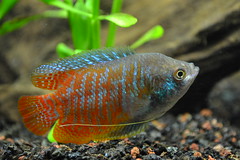
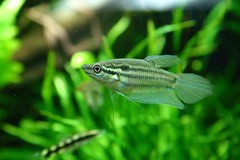
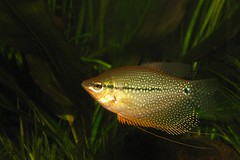
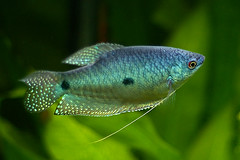
Four anabantoids commonly kept in aquariums.
Upper left: Dwarf gourami (Trichogaster lalius) (Photo by JonCornett);
Upper right: Croaking gourami (Trichopsis vittata) (Photo by S-kgy);
Lower left: Pearl gourami (Trichopodus leerii) (Photo by JohnInFlorida51);
Lower right: Three spot gourami (Trichopodus trichopterus) (Photo by K.Zadorozhny);
The Siamese fighting fish has been the subject of much artificial selection for colour and finnage; you can view photos of the stunning range of varieties in this Flickr group.
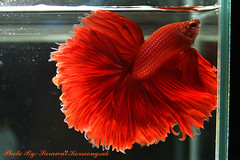
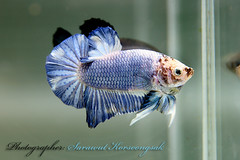
Two fancy varieties of Siamese fighting fish
Left: Super Red Half Moon; Right: Blue Monster Half Moon Plakat;
(Photos by Gao Hui)
Similarly, selectively bred colour varieties of the dwarf gourami and three spot gourami are widespread in the trade, perhaps even more so than the original 'wild' type.
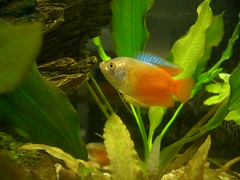

Left: Flame red dwarf gourami (Photo by Chaos Kitten); Right: Golden gourami (Photo by Salihan.com);
Two larger species seen in aquaria are the kissing gourami (Helostoma temminckii) and giant gourami (Osphronemus goramy), which are suitable only for those with very large aquariums; both these species are also widely raised for food in Southeast Asia, and have been introduced to several countries outside of their native range.
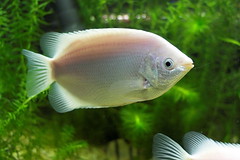
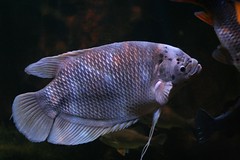
Left: Kissing gourami (Photo by obLiterated); Right: Giant gourami (Photo by andrew_mrt1976);
Here in Singapore, our anabantoid diversity is a mixture of native and non-native species. Interestingly enough, there are discrepancies between the list of freshwater fishes on the NParks website and that on FishBase; FishBase records the dwarf gourami and kissing gourami as having been introduced to Singapore, whereas these species are not in the NParks list. On the other hand, three species known to be native to Singapore are not in the FishBase list.
Among the non-native anabantoids that are suspected to occur in local waters, all are known to occur in the aquarium trade. These species are the kissing gourami, giant gourami, dwarf gourami, moonlight gourami (Trichopodus microlepis) and snakeskin gourami (Trichopodus pectoralis). The snakeskin gourami, although smaller than the kissing and giant gourami, is another species that is commonly raised for human consumption in the region.
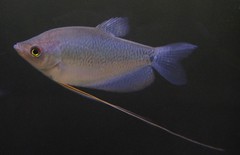

Left: Moonlight gourami (Photo by JadeRyu); Right: Snakeskin gourami (Photo by toyish0NE);
The native anabantoids include the climbing perch, forest betta (Betta pugnax) (which unlike the Siamese fighting fish, is a mouthbrooder), croaking gourami, three-spot gourami, and the bizarre-looking pikehead (Luciocephalus pulcher).


Two of our native anabantoids
Left: Forest betta (Photo by Nonn Panitvong); Right: Pikehead (Photo by Steve);
The status of Siamese fighting fish in Singapore is a confusing mess; while it is listed as an introduced species in A Guide to the Freshwater Fishes of Singapore and on the FishBase list, it is absent in the NParks list. However, both FishBase and NParks list another Betta species, the crescent betta (Betta imbellis), which is similar to the Siamese fighting fish, and which has been confused with the latter in the past. However, things only get more confusing, since both lists contradict each other; the crescent betta is listed as native in the NParks list, whereas FishBase lists it as introduced.
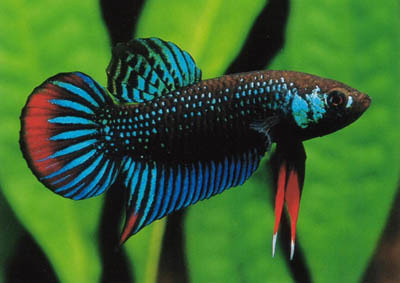
Crescent betta
(Photo by iwillmissyou_verymuch)
Depending on how you choose to interpret the lists, there are four possible scenarios:
- The crescent betta is a feral species in Singapore, and the Siamese fighting fish never established feral populations locally in the first place;
- The crescent betta is a native species, and the Siamese fighting fish never established feral populations locally in the first place;
- Both species are present in Singapore, with the crescent betta being a native and the Siamese fighting fish an introduced species;
- Both species were introduced and are present in Singapore.
I hope someone is actively trying to resolve this confusing state of affairs.
There is one final interesting fact about the anabantoids of Singapore. In 1994, a new species, Tom's giant betta (Betta tomi), was formally named and described by Peter Ng and Maurice Kottelat, based on specimens collected in Johor. Specimens recorded to have been collected from the Mandai area in 1937 were found, meaning that this species also once inhabited Singapore. Unfortunately, it is almost certain that Tom's giant betta is now locally extinct. In the words of the paper describing the species:
The area in Singapore where Herre collected his specimens has been completely changed and the best swamp forest in the area has already been lost to development and reservoir expansion. The authors and their colleagues have never encountered this species in Singapore.

Tom's giant betta
(Photo by Edward Miller)
It's some consolation that this species still exists in eastern Johor.
Besides the anabantoids, many other fish have the ability to breathe atmospheric air and move around on land, including the snakeheads (F. Channidae), swamp eels (F. Synbranchidae) and walking catfish (F. Clariidae). Recently, it has been discovered that the mangrove rivulus (Kryptolebias marmoratus) is capable of surviving dry spells by taking refuge in logs. Of course, the mudskippers (F. Gobiidae, subfamily Oxudercinae) are unparalleled in their terrestrial inclinations.
Also, while writing this post, I was reminded of the splash tetra (Copella arnoldi), a South American fish that actually spawns out of the water. Both the male and female leap out onto a leaf overhanging the water, and in the few moments before they fall back into the water, the female releases her eggs and the male fertilises them. The male will continue to remain nearby, ensuring that the eggs remain moist by splashing water with flicks of his tail. His job is done only when the eggs hatch and the free-swimming fry fall into the water.
There's more to say about fish out of water, but I'll have to stop here for now.